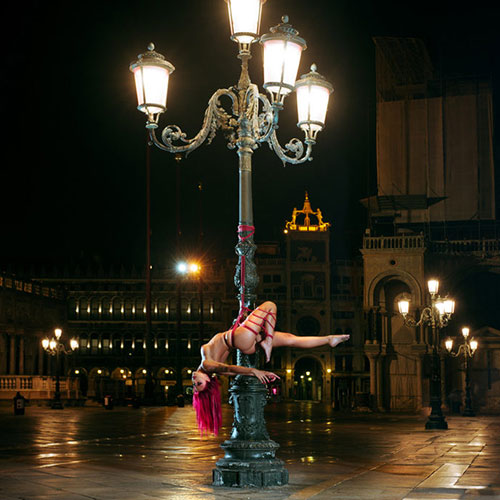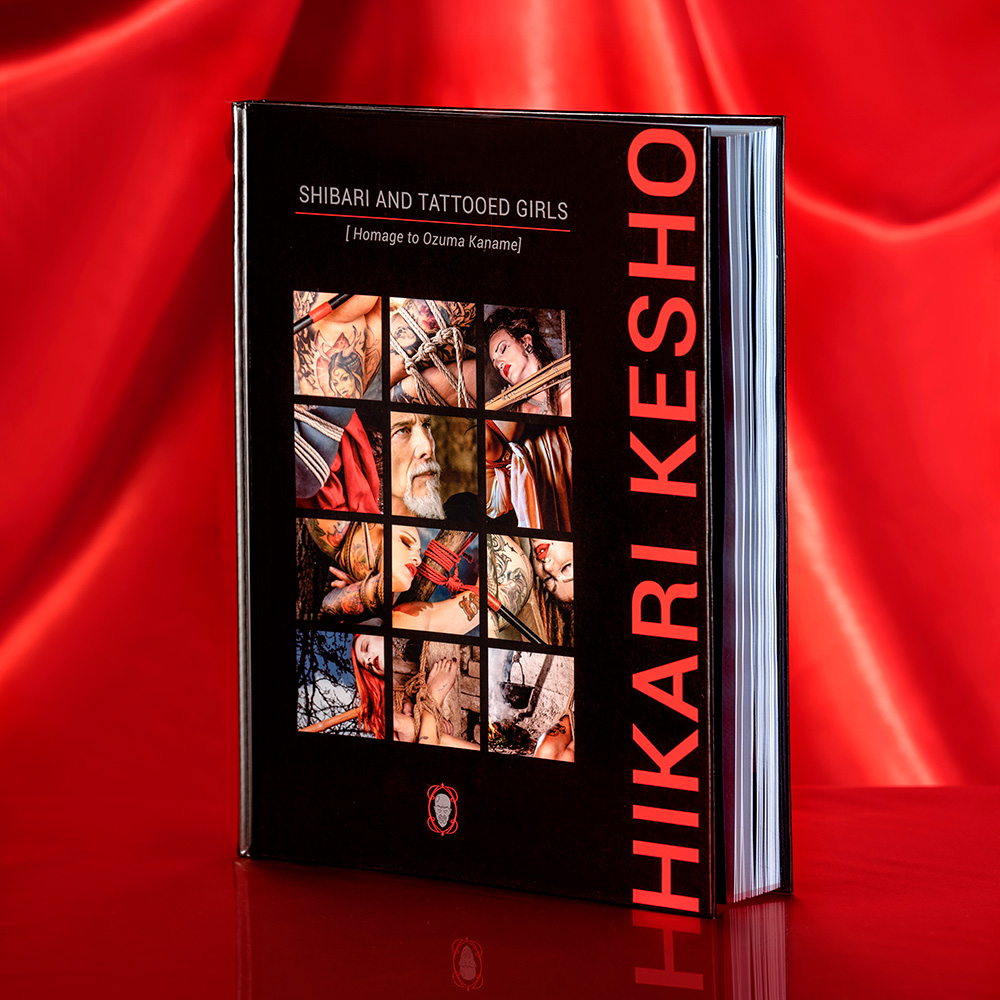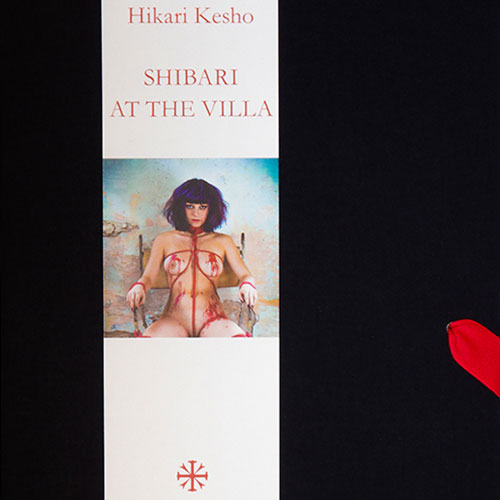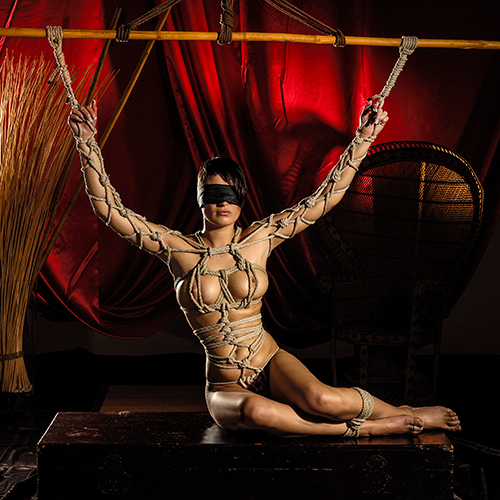Shibari, more correctly known as Kinbaku is an ancient Japanese artistic form of rope bondage that has many styles and uses. It is related in style to other traditional Japanese arts such as Ikebana, Sumi-e (black ink painting) and Chanoyu (the tea ceremony). Among the many uses of Shibari are dynamic living sculpture, shared meditative practice, deep relaxation for flexibility of mind and body, expression of power exchange, and intimate erotic restraint.
Shibari
ABOUT SHIBARI
Shibari, more correctly known as Kinbaku is an ancient Japanese artistic form of rope bondage that has many styles and uses. It is related in style to other traditional Japanese arts such as Ikebana, Sumi-e (black ink painting) and Chanoyu (the tea ceremony). Among the many uses of Shibari are dynamic living sculpture, shared meditative practice, deep relaxation for flexibility of mind and body, expression of power exchange, and intimate erotic restraint.
In Shibari (the action of tying someone up) the Nawashi (rope artist) creates almost geometric patterns and shapes that contrast wonderfully with the female body’s natural curves and recesses. Visually, the tight ropes and their texture provide a counterpoint to smooth skin and curves. The hard edges of the rope reinforce the softness of the body’s graceful shape: the model is like a canvas, and the rope is paint and brush. This contrast is even emphasized by the use of Junoesque models, whose generous curves are squeezed by the ropes to create more pronounced shapes and shadows.
From antiquity to today, religious ceremonies in Japan involve ropes and ties to symbolize connections among people and the divine, as well as to delineate sacred spaces and times.
Shibari Fetish Photography Everyday’s life was somehow tied together, just think of the Kimono, which has neither buttons nor hooks, but is closed by ritually tying long strips of fabric around the body. Military armor was made of lacquered wooden panels, elegantly tied together. Gifts were intricately wrapped and elaborately tied, and these custom holds true even today. Goods are prettily and functionally wrapped in the Furoshiki (square cloth), and packages are adorned with Mizuhiki (intricate cord tyings) so as to be pleasing to the eye.
The art of Japanese bondage has a long tradition and has been perfected over many centuries. It serves not only as binding but also as body adornment, and the pressure made by cords can employ Shiatsu techniques.
Shibari is built up of many ropes, each one doing its job, each one contributing to the total effect. Every knot has its historic significance and all of them have to do with the roots of Shibari in Hojo-jutsu (the martial art of restraining captives). There is even a form of bondage for noble captives where actual knots were not used at all and the prisoner was on his honor not to escape.
HISTORY OF SHIBARI
Originally Shibari started out as a form of incarceration in Japan from 1400 to 1700. At that time, the local police and Samurai used it as a form of imprisonment. The rope was multi-functional and was used not only for binding prisoners or hanging up the armor, but also for securing a saddle or tethering a horse.
There were no jails in Japan and very few metal resources. But they had lots of hemp and jute rope. So rope was what they used to immobilize prisoners. This is the origin of the martial art called Hojo-justu and other martial arts. Even today, police in Japan carry a bundle of hemp rope in the trunks of police cars in case they need it.
According to the earliest tradition of the Edo (1600-1868) period, there was a well-establisehd association between four colors (blue, red, white and black), the seasons, directions, and the four Chinese guards of the four directions (the dragon, the phoenix, the tiger and the tortoise). The color of the rope changed with the season, and the prisoner was restrained facing the direction appropriate to the color and season. By the end of the Edo period, the colors had been reduced to two, white and indigo.
Hemp was used for the real ropes while silk was used for practice upon straw dummies.
The honor of ancient Samurai warriors was rated on how well they took charge of their prisoners, and the technique used to tie the prisoner showed the honor and status of that Samurai. There were four rules of Hojo-jutsu:
- Not to allow the prisoner to slip his bonds.
- Not to cause any physical or mental injury.
- Not to allow others to see the techniques.
- To make the result beautiful to look at.
In the late 1800’s and early 1900’s a new form of erotic Hojo-justu evolved. This was called Kinbaku (the art of erotic bondage).
ROPE
For these photographs only two traditional Japanese materials were chosen: hemp rope and bamboo rods.
Finishing raw hemp rope is a process that takes a fair amount of time to do correctly. First, the hemp is boiled and carefully dried, then the stray strands are singed. Finally, mink oil is worked into the fibres. After completing the process you have a piece of rope that feels very similar to a sensual, although scratchy, Shetland wool sweater when it rubs across the skin.
Finished hemp rope has the perfect balance of textures, being both rough and soft, with a pleasant, grassy aroma. Hemp rope doesn’t stretch like braided nylon or polypropylene and it holds a knot remarkably well. It also has a lower tendency to produce “rope burn” than synthetic ropes.
8mm and 6mm rope is great for general bodywork such as torso harnesses, pelvic harnesses, breast bondage, and ankle or wrist cuffs. Good working standard lengths are the 25 feet for torso/pelvic work and 12.5 ft lengths for wrist or ankle cuffs. Since all the models photographed are rather oversized, the standard lengths had to be modified according to the model.
HEMP
Hemp appeared in Japan during the Neolithic Jomon period (10,000 to 300 BC). The term Jomon itself means “pattern of ropes” which were certainly made of hemp. As time went on, hemp had successfully adapted to the Japanese climate and spread throughout the archipelago. Even on the northern island of Hokkaido, the indigenous Ainu made their colourful costumes from the fibre during the Yayoi period (around the 3rd century AD).
During the feudal era, hemp cultivation was encouraged by the Daimyo (feudal lords). Hemp (along with silk for the wealthy Samurai class) was the primary source of clothing fibre until the 17th century when cotton was introduced.
It continued to be used for a variety of specialized purposes, including the straps of Geta (high wooden sandals) and ropes.
The meditative, Taoist-influenced branch of Buddhism called Zen was also influenced by hemp. Samurai and scholars who followed ots tenets express hemp’s inspiration in arts like Haiku (short poems), Aikido (a martial art), Kyudo (archery) and Chanoyu (tea ceremony).
During an elaborate pre-bout ceremony called Dohyo-iri, in Sumo , the reigning Yokuzuma (grand champion) carries a giant hemp rope around his ample girth to purify the ring and exorcise the evil spirits.
BAMBOO
The use of bamboo is culturally natural to the Japanese. Bamboo has played an indispensable role in Japanese society since early times; strong, light and flexible, it has been put to a wide range of uses. Aside from its basic purposes, it is also used in more elaborate bondage.
Bamboo combs and baskets have been unearthed at Jomon Period archaeological sites in both Honshu and Kyushu. These finds prove that bamboo groves grew over a wide area of Japan and that bamboo had been in use since earliest times. It is thought that people began to eat bamboo shoots in this period. Sites from the Nara Period (710-794) show that bamboo was used to make holders for writing brushes and musical instruments like the Shakuhachi (Japanese flute).
During the Kamakura and Muromachi Periods (1192-1573), bamboo was also used to make bows and arrows. Bamboo was an essential material in the distinctive Sukiya-Zukuri style of architecture which appeared during the Azuchi-Momoyama (1573-1603) and Edo (1600-1868) Periods. Even tea utensils used in the elaborate Chanoyu (tea ceremony) are still fashioned from different species of bamboo.
SHIBARI AND SHIATSU – IKEBANA
Shibari is a combination of bondage effects as most of us know them (power, helplessness), but also beauty and aesthetics (it can be compared to Japanese Ikebana, the 700 year-old Japanese art of flower arranging). The intense massage by the ropes and knots is very similar to acupuncture techniques and Shiatsu (a form of Japanese massage).
The art of arranging ropes and knots on the model’s body according to a strict sense of aesthetics reflects the cultural heritage of Ikebana, which emphasizes characteristics like sensuality, vulnerability, and strength. On the other hand, Shibari is simply a static monument.
The concept of positioning knots to stimulate pressure points on the body is derived from Shiatsu. The skilled Nawashi uses his knowledge of massage and pressure points to get those thick knots in just the right places. There are crossover influences and effects between Shibari and the traditional Asian medical philosophy of Ki-energy, meridians and Trusbo (pressure points), used in Shiatsu and other Bokam (traditional oriental medicine) techniques.
 torna a gallery
torna a gallery





